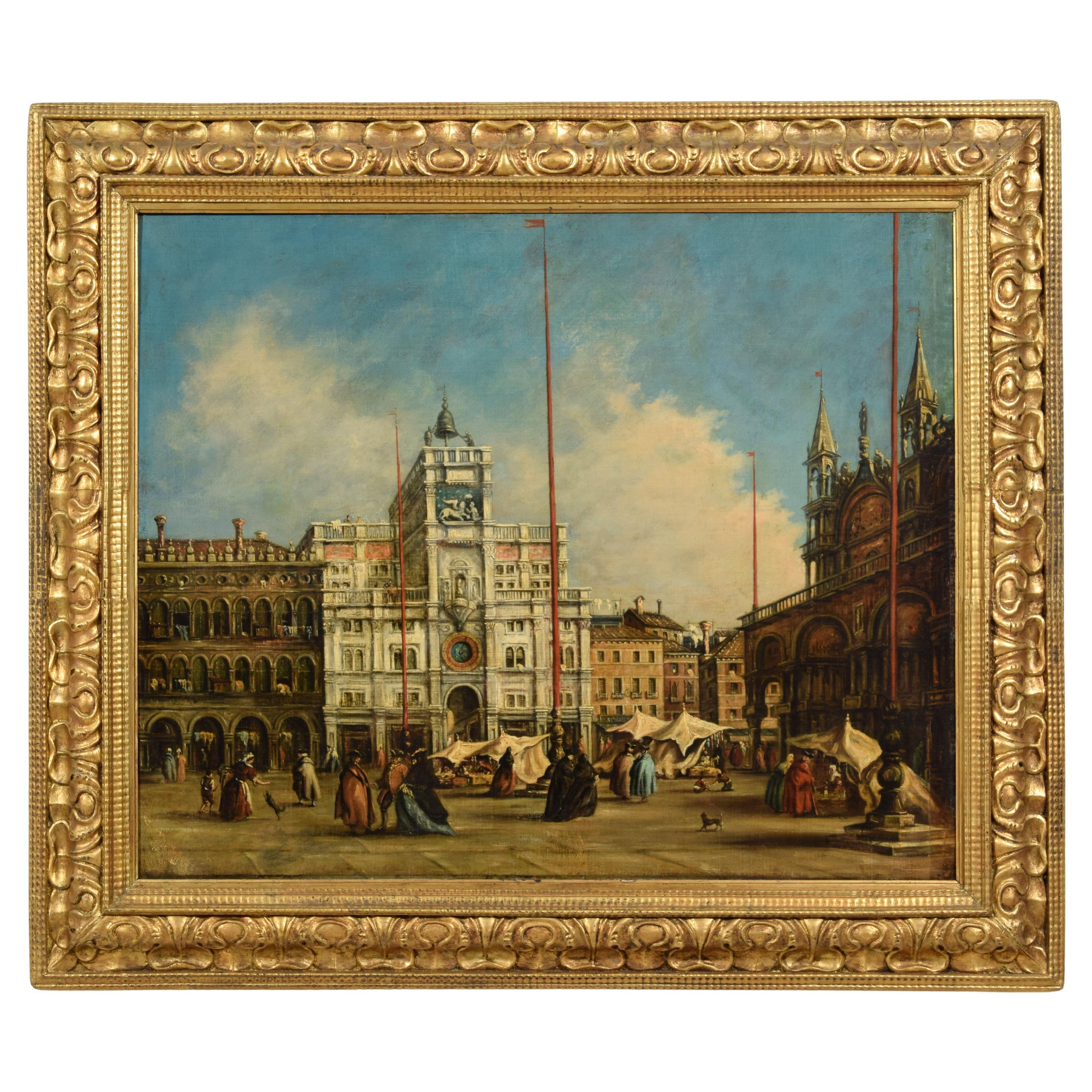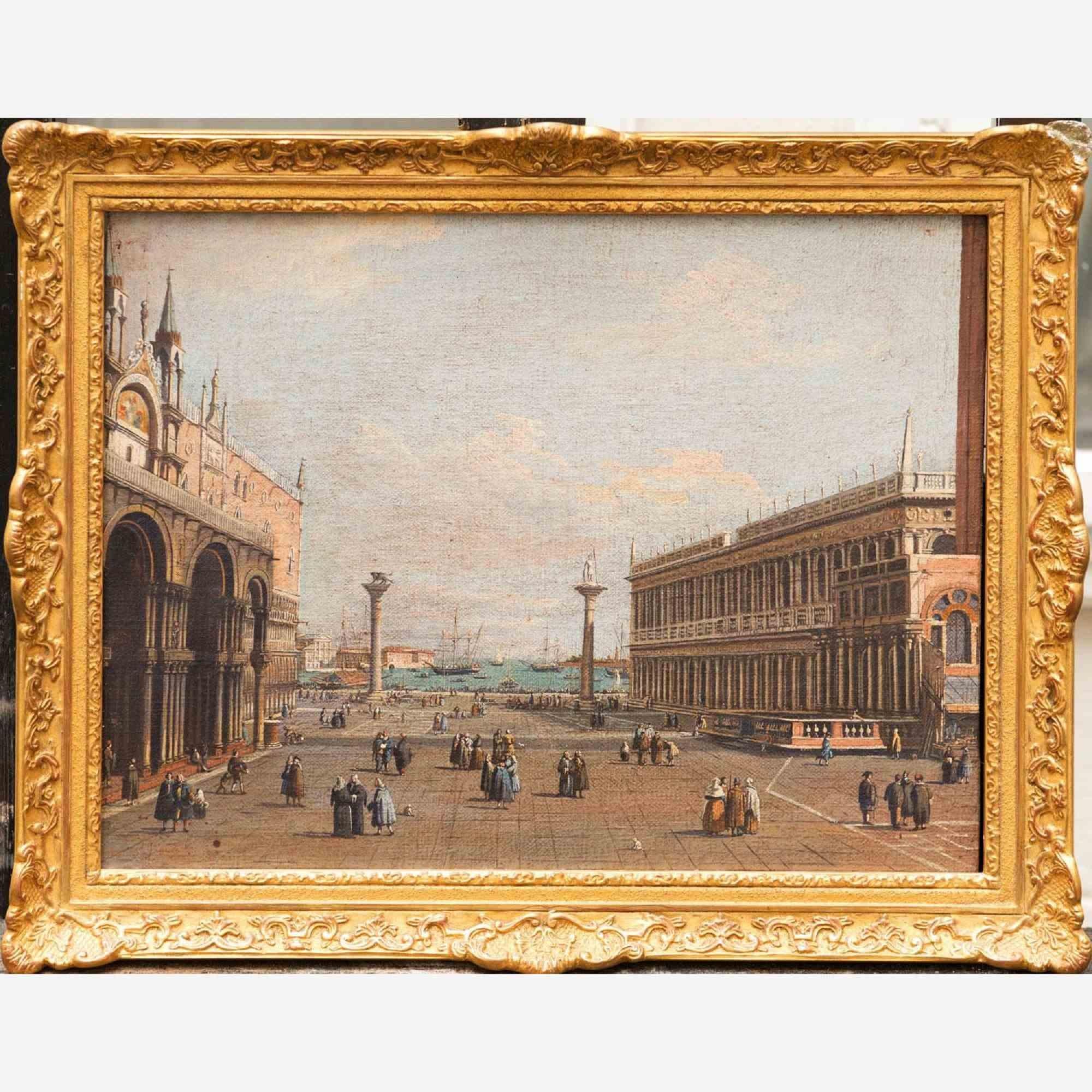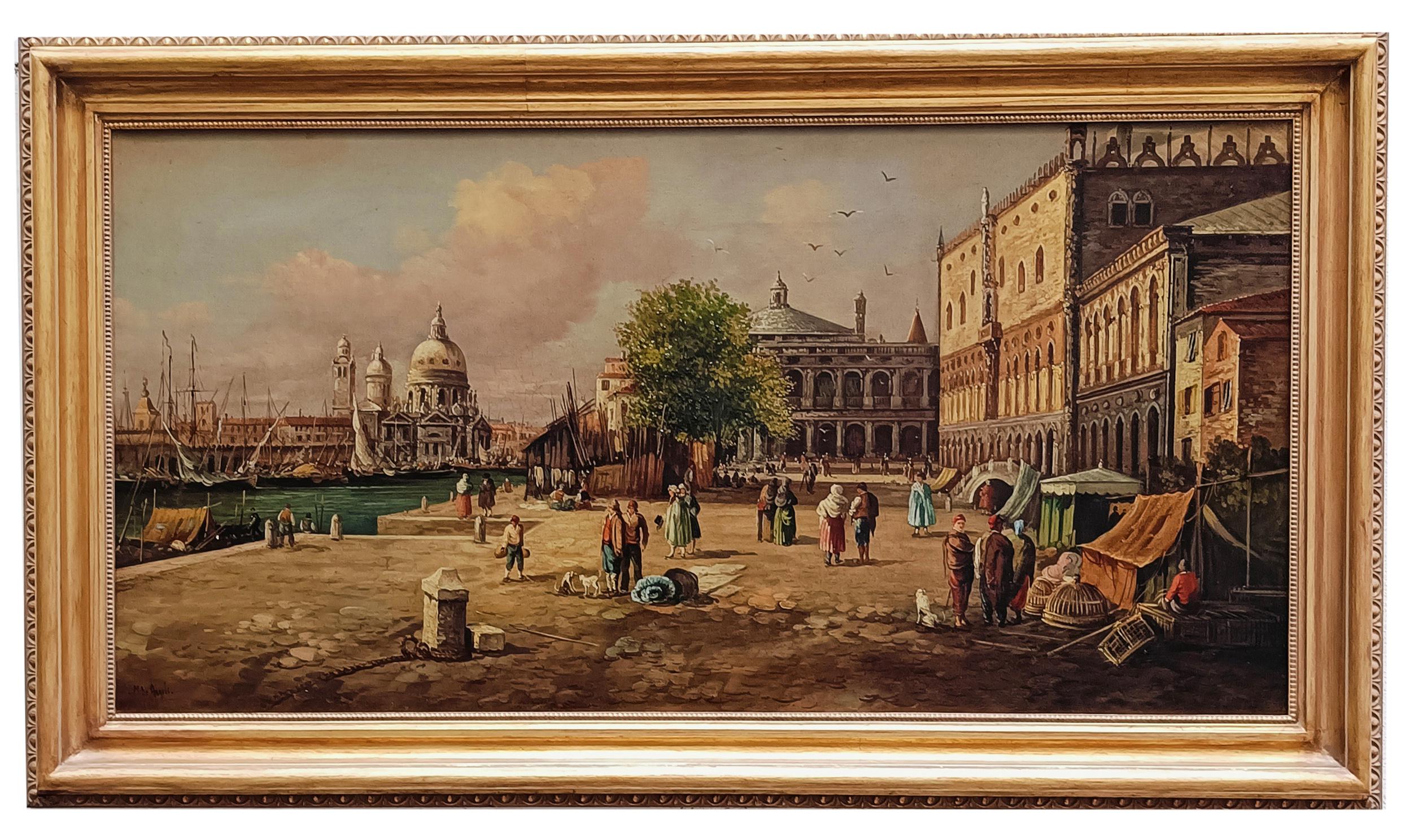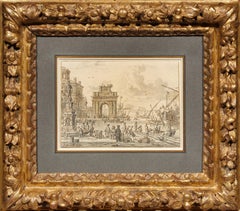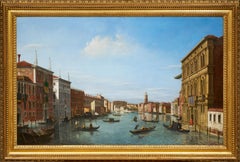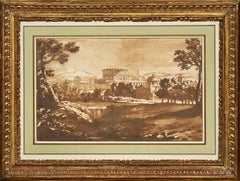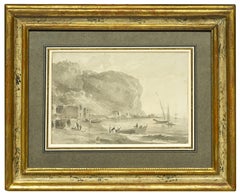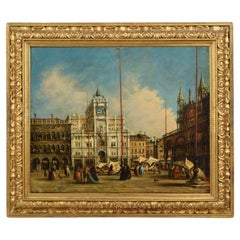Items Similar to View of Piazza San Marco, a tempera signed by Giacomo Guardi (1764 - 1835)
Want more images or videos?
Request additional images or videos from the seller
1 of 6
Giacomo Guardi View of Piazza San Marco, a tempera signed by Giacomo Guardi (1764 - 1835)circa 1793 - 1815
circa 1793 - 1815
$17,715.84
£13,337.32
€15,000
CA$24,404.74
A$27,331.76
CHF 14,261.27
MX$333,845.75
NOK 181,444.82
SEK 171,033.48
DKK 114,182.03
About the Item
Signed and localized on the verso :
"Vedute di parte dalla Piazza dif.a alla Loggetta e cam
panil parte della Zecca ed in lontan Proc.e vechie e parte della chiesa
punto preso vicin alla mettà del Pallozzo Ducale
Giacomo de Guardi
Frame: Canaletto-style Venetian frame in carved and gilded wood
In this tempera "postcard", Giacomo Guardi, Francesco's son and the last artist of the dynasty, offers us a view of Piazza San Marco inspired by a painting by Canaletto. The artist bathes this urban landscape in the rosy light of late afternoon, as evening begins to fall and the shadows lengthen.
The indication on the verso explains where this panoramic view is supposed to have been taken from : in front of the Doge's Palace, looking towards the campanile. The lack of distance at this point means that the campanile had to be cut off, lending a certain "photographic" modernity to this vedutina, which has probably been executed at the very beginning of the 19th century.
We would like to thank Carolina Trupiano Kowalczyk for her help with the photo of Piazza San Marco.
1. Giacomo Guardi, or the difficulty of being the son of a genius (of painting)
Little is known about the life of Giacomo Guardi, born in Venice in 1764 to relatively elderly parents (his father Francesco was fifty-one and his mother Maria Mathea Pagani thirty-eight). Modestly gifted, he shared his father's studio for some ten years, from the early 1780s until the latter's death on January 1, 1793, first as an apprentice and then as a collaborator.
Unlike his first cousin Giovanni Domenico Tiepolo (1727 - 1804), who helped his father with his large-scale fresco projects, Giacomo Guardi found it difficult to free himself from his father's tutelage. His father did not hesitate to sign his son's paintings with his own name to make them more marketable, and had authorized his son to do the same (only one canvas is known to have been signed with Giacomo Guardi's name ), and Giacomo Guardi did not hesitate to complete drawings left unfinished by his father to make them more attractive, while signing them with his father's name...
It was probably after his father's death that he gave up painting to devote himself entirely to the production of vedutine, these small views of Venice which, together with the sale of the artworks left by his father, would provide him with an income for the rest of his life. He died in 1835, with no heir, and was succeeded by his first cousin Nicolo Guardi (1773 - 1860).
2. The Vedutine
These "small views", executed in black and white or with tempera colors, are the most original aspect of Giacomo Guardi's production. Like his cousin Lorenzo Tiepolo with pastels, Guardi seems to have found in tempera the medium best suited to his abilities. Seeking to render Venetian sites realistically and meticulously, he enlivened them with a host of soberly sketched characters in contemporary dress (some sixty figures and four dogs in the one we are presenting, a detail of which is reproduced below), confering them an undeniable naive charm.
"Postcards" equivalent bought by "foreign" travelers (in Venice, anyone who wasn't Venetian was necessarily a foreigner) from Italy, England, France or Germany, these vedutine were not intended to be sent by mail, but were prized travel souvenirs, to be pasted into albums (most of which have now been dismembered) or framed once back in the mother country. They are usually signed on the back "Giacomo de Guardi", in reference to the noble title granted to the family by the Emperor in 1643. The signature is usually preceded by a few lines explaining the exact location of the view and the monuments depicted, and sometimes even the artist's address!
Most of them have been executed in the same turquoise chromatic range, a very luminous but a little unreal one ("lunar" to use Morassi's expression). The one we present is characterized by a magnificent atmospheric rendering of the dewy light of a fine late afternoon.
3. An unusual view of Piazza San Marco
Giacomo Guardi presents an unusual view of Piazza San Marco, the center of Venetian life past and present. He probably drew his inspiration from a painting by Canaletto dated 1744, engraved by Visentini (whose preparatory drawing is kept in the Correr Museum in Venice).
As in Canaletto's painting, the view is taken from a high vantage point, and several views have been combined to obtain a complete panorama, which would be impossible from a single vantage point. Today, only a panoramic effect allows you to take a similar photo, standing slightly inside the gallery of the Doge's Palace.
On the verso, Giacomo Guardi lists the main surrounding buildings: in the center, the Campanile with the Loggetta at its feet; on the left, the Zecca (mint) building, which is invisible because it stands behind Sansovino's Libreria; in the background, the Ancient Procuraties, which line the north side of Piazza San Marco; and finally, on the right, the southwest corner of the San Marco Basilica.
San Marco was known as the Palatine Church (chiesa palatina) of the Doge's Palace until 1807, when it was elevated to the rank of cathedral basilica. This name ("Chiesa") used by Guardi in the description on the verso suggests that our view was executed at the very beginning of the 19th century, a fact corroborated by the absence of Austrian uniforms, so common in Giacomo Guardi's views dating from after 1815 (the date when Venice became part of the Austrian Empire).
4. Framing
To frame this vedutina, we have chosen a Canaletto-style Venetian frame in carved and gilded wood.
Main bibliographical references :
Antonio Morassi - L'opera completa di Antonio e Francesco Guardi - Alfieri Venezia 1973
Dario Succi - Guardi Itinerario artistico - Editoriale Giorgio Mondatori 2021
- Creator:Giacomo Guardi (1764 - 1835)
- Creation Year:circa 1793 - 1815
- Dimensions:Height: 4.25 in (10.8 cm)Width: 7 in (17.78 cm)
- Medium:
- Movement & Style:
- Period:
- Condition:Dimensions : 4 ¼ ‘’ x 7 ‘’ (108 x 175 mm) – Framed : 8 5/8’’ x 11 7/16’’ (22 x 29 cm) Frame: Canaletto-style Venetian frame in carved and gilded wood.
- Gallery Location:PARIS, FR
- Reference Number:1stDibs: LU1568213998242
About the Seller
5.0
Vetted Professional Seller
Every seller passes strict standards for authenticity and reliability
Established in 2020
1stDibs seller since 2021
10 sales on 1stDibs
Typical response time: 2 hours
- ShippingRetrieving quote...Shipping from: PARIS, France
- Return Policy
Authenticity Guarantee
In the unlikely event there’s an issue with an item’s authenticity, contact us within 1 year for a full refund. DetailsMoney-Back Guarantee
If your item is not as described, is damaged in transit, or does not arrive, contact us within 7 days for a full refund. Details24-Hour Cancellation
You have a 24-hour grace period in which to reconsider your purchase, with no questions asked.Vetted Professional Sellers
Our world-class sellers must adhere to strict standards for service and quality, maintaining the integrity of our listings.Price-Match Guarantee
If you find that a seller listed the same item for a lower price elsewhere, we’ll match it.Trusted Global Delivery
Our best-in-class carrier network provides specialized shipping options worldwide, including custom delivery.More From This Seller
View AllImaginary View of an Italian Port, a signed and dated drawing by Jacobus Storck
Located in PARIS, FR
In this finely executed pen and wash drawing, Jacobus Storck presents us with an imaginary view in an Italian port. The splendor of the buildings (the large sculpted fountain surmoun...
Category
1680s Old Masters Landscape Drawings and Watercolors
Materials
Paper, Pencil, Pen, Ink
View of the Grand Canal, a painting by William James, after Canaletto
By William James
Located in PARIS, FR
Although we have little bibliographical information on William James, we know that he was trained by Canaletto during the painter's stay in England between 1746 and 1755. Although he may never have been to Venice, William James remained under the influence of his master for a long time and became known for his paintings inspired by Canaletto's artworks.
In this painting, William James is inspired by one of the twelve views of the Grand Canal painted by Canaletto for Joseph Smith, or more precisely by the engraving made by Antonio Visentini in 1735 after this painting. He delivers a very personal version, vibrant with colours, in which he brilliantly reproduces the moving surface of the sea, animated by the ever-changing traffic of the gondolas.
1. William James, the English follower...
Category
Mid-18th Century Old Masters Landscape Paintings
Materials
Canvas, Oil
View of an Antique City, a wash landscape by Jan de Bisschop (1628 - 1671)
Located in PARIS, FR
The attribution to Jan de Bisschop has been confirmed by the RKD with the following comment: "We base this attribution on the dark washes, the subject represented and the monogram".
...
Category
17th Century Old Masters Landscape Drawings and Watercolors
Materials
Ink, Pen
View of the Posillipo coastline near Naples by William Marlow (1740 - 1813)
By William Marlow
Located in PARIS, FR
In this drawing, inspired by his stay in Naples in 1765, William Marlow presents us with a view of Cape Posillipo, to the west of Naples, an essential stage during the Grand Tour. Th...
Category
1760s Old Masters Landscape Drawings and Watercolors
Materials
Ink
View of the Ovo Castle in the Moonlight, a 19th century Neapolitan gouache
Located in PARIS, FR
Neapolitan gouaches appeared in the eighteenth century when tourism in the Naples area was developing: the discoveries of Herculaneum and Pompeii made this city a mandatory stop on the Grand Tour, the journey made by wealthy Europeans to complete their education.
Generally small in size for ease of transport and affordable in price, these gouaches were the ideal travel souvenir that these tourists of the early days were bringing back to capture the idyllic landscapes they had discovered during their journey and to share them with family and friends upon their return at home.
The Bay of Naples and the eruptions of Vesuvius are the favourite themes of these views. Here we have a view of the Ovo Castle, which was rebuilt on the island of Partenope, in the middle of the Bay of Naples and about a hundred metres from the shore by the Normans in the 12th century on antique ruins...
Category
Early 19th Century Romantic Landscape Drawings and Watercolors
Materials
Gouache, Paper
A dazzling Venetian Regatta Boat Study attributed to Alessandra Mauro
Located in PARIS, FR
This stunning Baroque study depicts a regatta boat, a type of vessel developed in eighteenth-century Venice for the regattas organized by the Serenissima during visits by royalty and princes. We propose to link this drawing to the work of Alessandro Mauro, an artist who specialized in this type of composition, as illustrated by a drawing from him at the Metropolitan Museum.
1. Description of the boat
The greatest decorative fantasy reigns in this preparatory study, which blends mythological and exotic elements with references to ancient Egypt. Our drawing is probably an initial thought, destined to be refined and clarified later in pen and ink (as evidenced by the ink stain in the lower right). A quadriga of seahorses guided by Neptune stands at the stern of the boat, shown well above the waterline (perhaps to outline its empty volume). One of the seahorses is ridden by a newt, while Amphitrite lies at the feet of the sea god.
The center of the boat is occupied by a vast baldachin resting on four atlantes and surmounted by a figure riding an animal (a dragon?). Three figures sit beneath the canopy, one of them on a griffin-shaped seat. This allusion to Egyptian antiquity echoes the winged sun (sometimes a symbol of the god Horus, as in the temple of Edfu in Egypt) that adorns the sides of the promontory on which this baldachin rests.
Another flag-bearer figure crouches at the stern of the boat on a raised seat, on the reverse of which is a crowned mermaid whose arm, extended backwards, rests on a mascaron decorated with a radiant face (Helios?) and whose torso surmounts an elephant's head. The heads of the rowers and their oars are sketched all along the boat, whose sides are embellished with elongated naiads.
2. The Venetian regatta boats
An exhibition held in 2013 at the Ca' Rezzonico (the Venetian eighteenth-century museum) paid tribute to these regatta boats through studies and prints depicting them. The regattas organized by the Serenissima in honor of visiting princes and sovereigns were among the most spectacular ceremonies in Venice. Some important artists of the 18th century contributed to the creation of these extravagant boats which were given exotic names such as bissona, malgarota or peota.
The specialists in this field were Andrea Urbani and the brothers Alessandro and Romualdo Mauro. They were born into a family of theater decorators in Piedmont, but little is known about their detailed biography. Alessandro was the architect of the Dresden opera house and of the St. Samuel Theater in Venice (in collaboration with his brother Romualdo), but also worked as stagehand and set designer in Vienna, Rome and Turin. A drawing produced around 1737 from the Metropolitan Museum (7th photo in the gallery) bears witness to his activity as a regatta boat designer.
This drawing is a much more elaborate version than the one presented here, having been entirely reworked in brown ink. However, a figure at the bow of the boat, executed solely in black chalk, still bears witness to a technique similar to that of our drawing.
It is difficult to know whether the boat depicted in our drawing was a project for an actual boat or whether it remained in the planning stage, but the front of our boat (Neptune and the quadriga of seahorses ridden by a newt) bears several similarities to that of a parade boat depicted in the print published by Michele Marieschi entitled Regatta on the Grand Canal, between the Foscari and Balbi Palaces (last photo in the gallery). This print is dated 1741, which could confirm that our work dates from around 1740.
The area between Neptune and the quadriga that precedes him on this strange paddle-boat appears to be partially submerged, confirming that the waterline of our boat was probably intended to be much lower than the one shown in our drawing.
The Correr Museum’s collection holds one of the most important collection of engravings and drawings devoted to these specifically Venetian Baroque productions. These boats were intended to last the duration of a festival. Today, they are only documented by preparatory drawings or prints that testify to the sumptuousness of their decoration. This taste for regatta boats lasted throughout the Venetian eighteenth century, and the conception of regatta boats also attracted great masters such as Giambattista Tiepolo, Francesco Guardi or Giambattista Piranesi...
Category
Mid-18th Century Old Masters Figurative Drawings and Watercolors
Materials
Chalk
You May Also Like
19th Century, View of Piazza San Marco in Venice, Follower of Francesco Guardi
By Francesco Guardi
Located in IT
19th Century, View of Piazza San Marco in Venice, Follower of Francesco Guardi
Dimensions: frame, cm W 121.5 x H 105 x D 5.5. Canvas cm W 100 x H 81
The work, created by a Venetian ...
Category
Antique 19th Century Italian Neoclassical Paintings
Materials
Canvas
Vintage Italian Painting of Piazza San Marco As Seen from the Lagoon
Located in Douglas Manor, NY
6010 Vintage Italianpainting of Piazza San Marco as seen from the lagoon
Gilt frame
Signed
Category
1960s Landscape Paintings
Materials
Oil
View of St. Mark Square - Oil Paint on Canvas - Late 18th century
By Giovanni Antonio Canal (Canaletto)
Located in Roma, IT
View of St. Mark Square is an original old master artwork realized in the late 18th century by artist of the School of Giovanni Antonio Canal (C...
Category
Late 18th Century Modern Landscape Paintings
Materials
Canvas, Oil
19th Century Oil Painting of St Mark's Square in Venice from the Ducal Palaca
By Edward Pritchett
Located in Gerrards Cross, GB
‘Piazza San Marco from the Palazzo’ by Edward Pritchett RWS (1807-1876).
The painting – which depicts St. Mark’s Square and the Campanile seen from the Porto della Carta entrance to...
Category
Mid-19th Century English School Landscape Paintings
Materials
Oil
View of busy St. Mark's Square with the Doge's Palace
Located in San Francisco, CA
This artwork titled "View of busy St. Mark's Square with the Doge's Palace" c.1950, is an oil painting on canvas by noted Italian artist Marcello Vianello, 1909-1985. It is signed at...
Category
Mid-20th Century Impressionist Figurative Paintings
Materials
Oil
VENICE-In the Manner of Canaletto - Italian Landscape Oil on Canvas Painting
By Mario De Angeli
Located in Napoli, IT
Venice - Mario De Angeli - Italia 2008 - Oil on canvas cm. 60x120.
Mario De Angeli's canvas is an extraordinary work of Italian landscape painting.
They are inspired by the landsc...
Category
Early 2000s Italian School Landscape Paintings
Materials
Gold Leaf
More Ways To Browse
Venetian Frames
Antique View Master
Signed Postcards
Old Master Sketch
Tempera On Wood
Antique Tempera Painting
Italian View Of Venice Painting
Drawings Of Dogs
Old Masters Paintings Of Venice
The Empire Of Light
San Marco Italy
San Marco Painting
French Noble Painting
Dior Postcards
Venice San Giorgio
Venetian Dress
German Wood Carved Figures
Piazza San Marco
